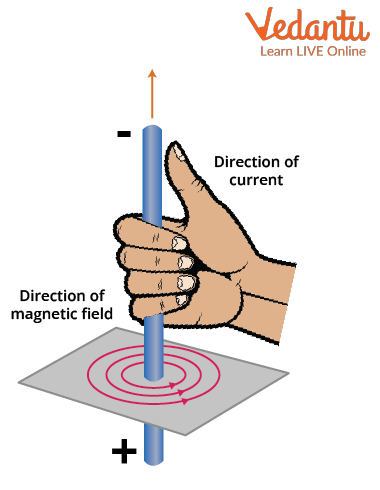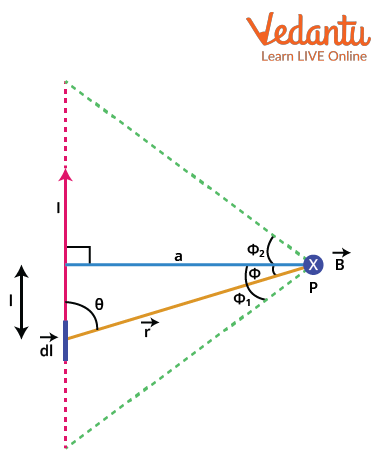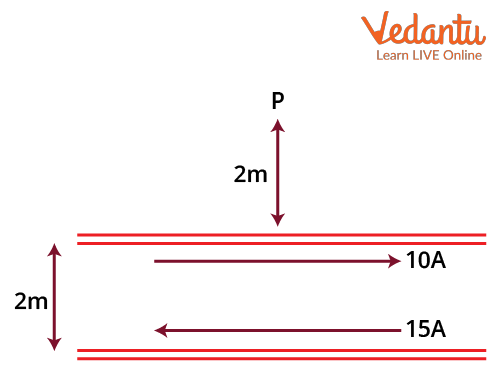




Access Magnetic Field Due to a Straight Current-Carrying Wire: Explanation and Formula
The magnetic field produced by a straight current-carrying wire is a fundamental concept in electromagnetism, essential for understanding how electrical currents generate magnetic forces. When an electric current flows through a conductor, it creates a magnetic field around the wire. This field is circular, and its strength depends on the current and the distance from the wire.
In this section, we will explore the formula for the magnetic field due to a straight wire, the derivation of this formula, and its significance in various real-world applications, such as electromagnets and electric motors. Understanding this concept is crucial for students preparing for competitive exams like JEE Main. Let’s dive deeper into the principles and calculations behind the magnetic field of a straight current-carrying wire.
What is Magnetic Field Due to Straight Wire Carrying Current?
The magnetic field due to a straight wire carrying current refers to Magnetic fields that are produced when current passes through a wire or a loop. Moreover, a strong current is required to produce a strong magnetic field. A long straight wire carrying current will produce a magnetic field. If we place another current-carrying wire in its vicinity, it experiences a force that is produced by the first current-carrying wire.
We derive this force on the wire using Biot's Savart's Law. Biot Savart’s law states the relationship between a current-carrying wire and a point P placed at a distance r from the wire. The magnitude of this magnetic field is inversely proportional to the square of the distance of wire to the point P kept at distance r.
Magnetic Field Due to Straight Current Carrying Wire Formula
The magnetic field due to straight wire is produced by moving charges. The direction of this current can be found out from Maxwell's right thumb rule.

Right Hand thumb Rule
Right Hand Thumb Rule: The right hand thumb rule states that when we curl our fingers in the direction of the magnetic field, the direction of the thumb gives the direction of the current. Inversely, it can also be stated that if the thumb represents the direction of current, then the fingers denote the direction of the magnetic field.
Assuming a long straight current carrying a wire of magnitude I, the magnetic field (B) created by the conductor is formed around it. The magnetic field also further depends on the distance of the wire. Thus, the magnetic field created by the current-carrying wire is denoted as the ratio of the product of magnetic permeability and current to its distance from the wire. Mathematically, it can be denoted as :
$B=\dfrac{\mu{ }_{o}I}{2 \pi r}$
where
$\mu$ is the permeability of free space or $4\pi\times10^{-7}~\left(\dfrac{T\cdot m}{A}\right)$.
B is the magnetic field measure in tesla.
I is the current intensity flowing in the long wire.
r is the distance of the magnetic field from the wire.
Magnetic Field Due to Straight Current Carrying Wire Derivation
Suppose we assume a point P at a distance r from a long straight wire carrying current I.

Magnetic Field due to Long Straight Wire
Now, according to Biot Savart’s Law, the magnetic field of a point P placed at a distance r is
$ \mathrm{d} B=\dfrac{\mu_{\theta} I d l \sin (\theta)}{4 \pi r^{2}}$
From the figure, it can be seen that
$\begin{align} &r=\sqrt{a^{2}+l^{2}} \\ &\sin \theta=\dfrac{r}{\sqrt{a^{2}+l^{2}}} \end{align}$
We need to calculate the magnetic field for the entire conductor. We can find this by integrating the equation for half the wire and multiplying it by 2. Then, the limits of the integral will be from 0 to infinity.
The integration gives
$\int d B=2 \times \int_{0}^{\infty} \dfrac{\mu_{0} I}{4 \pi} \dfrac{1}{\left(\sqrt{r^{2}+l^{2}}\right)^{2}} \dfrac{r}{\sqrt{r^{2}+l^{2}}} \mathrm{~d} l$
$B=\dfrac{\mu_{0} I}{2 \pi} \int_{0}^{\infty} \dfrac{r}{\left(r^{2}+l^{2}\right)^{3 / 2}} \mathrm{~d} l$
$B=\dfrac{\mu_{0} I}{2 \pi r}\left[\dfrac{l}{\left(r^{2}+l^{2}\right)^{1 / 2}}\right]_{0}^{\infty}$
$\begin{align} &B=\dfrac{\mu_{0} I}{2 \pi r}\left[\lim _{l \rightarrow \infty}\dfrac{l}{l\left(\dfrac{r^{2}}{l^{2}}+1\right)^{\dfrac{1}{ 2}}}-0\right] \\ &B=\dfrac{\mu_{0} I}{2 \pi r}\left[\dfrac{1}{\left(\dfrac{r^{2}}{\infty}+1\right)^{\dfrac{1}{ 2}}}-0\right] \\ &B=\dfrac{\mu_{0} I}{2 \pi r}[1-0] \\ &B=\dfrac{\mu_{o} I}{2 \pi r}\end{align}$
Thus, the magnetic field due to a long straight current carrying wire is inversely proportional to the distance of a point P from the wire.
Electric Field Due to Straight Wire
The electric field for a long straight current-carrying wire is denoted as: $E=\dfrac{\lambda}{2 \pi \in{ }_{o}{r}}$
where r is the distance of the electric field from the wire, $\lambda$ is the linear charge density, and $\in_{o}$ is the permittivity whose value is 8.854 $\times$ 10-12 .
This field can be calculated by considering an infinitely long straight wire and then using a cylindrical gaussian surface. The gauss law can then be used to find the electric field of this straight wire.
Solved Examples on Magnetic Field Due to Long Straight Wire
Example 1: A wire of 60 cm in length carries a current I= 4 A. What is the magnetic field at 50 cm from the wire?
Solution:
As derived from above the formula, magnetic field of a straight line is denoted as:
$B=\dfrac{\mu I}{2 \pi r}=\dfrac{4 \pi \times 10^{-7} .4}{(2 \pi \times 0.6 m)}=13.33 \times 10^{-7}$
Thus, the value of the magnetic field comes out to be 13.33 $\times$ 10-7 tesla.
Example 2: A wire of 60 cm in length carries a current I= 3 A. At which distance is the magnetic field 2 $\times$ 10-3 T?
Solution:
As derived from above the formula, magnetic field of a straight line is denoted as:
$\begin{align}&r=\dfrac{\mu I}{2 \pi B}=\dfrac{4 \pi \times 10^{-7} \times 3}{2 \pi \times 2 \times 10^{-3}} \\ &r=0.6 \times 10^{-4} \mathrm{~m}=0.06 \mathrm{~mm} \end{align}$
Thus, the distance at which the magnetic field is 2 $\times$ 10-3 T is 0.06 mm.
Example 3: Find the electric field at 6m from an infinitely long wire with a linear charge density of 8 x 10-3 $\dfrac{C}{m}$.
Solution:
Given r = 5m and $\lambda$= 8 $\times$ 10-3 cm. Substituting these in the above formula, we get,
$\begin{align}E=\dfrac{\lambda}{2 \pi \in{ }_{o}^{r}} \\E=\dfrac{8 \times 10^{-3}}{2 \pi \times 6 \times 8.854 \times 10^{-12}}\\ E=0.047 \times 10^{9}\,N/C \\ \end{align}$
Hence, the value of electric field is $0.047 \times 10^{9}\,N/C$.
Example 4: A straight current-carrying conductor is carrying a current of 10A and another conductor parallel to it carries a current of 15A on the opposite side as shown in the figure below. Find the magnitude of the magnetic field produced by the system at a distance of 2 m.

Diagram for the problem
Solution: The problem has two wires. Now we can find the magnetic field by individual wires and then add them to get the total magnetic field. Let the magnetic field by wire carrying 10A current be B1. We can write B1 as
$\begin{align} &B_{1}=\dfrac{\mu_{o}{I}_1}{2 \pi r_{1}} \\ &B_{1}=\dfrac{2 \mu_{o} \times 10}{4 \pi \times 2} \\ &B_{1}=10^{-7} \times 10 \\ &B_{1}=10^{-6} \mathrm{~T} \end{align}$
Similarly, the magnetic force B2 by second wire carrying current 15 A and at distance 4m from P can be given as
$\begin{align} &B_{2}=\dfrac{\mu_{0} I_{2}}{2 \pi r_{2}} \\ &B_{2}=\dfrac{2 \mu_{0} \times 15}{4 \pi \times 4} \\ &B_{2}=10^{-7} \times \dfrac{15}{2} \\ &B_{2}=0.75 \times 10^{-6} \mathrm{~T} \end{align}$
Now, both the wires have opposite directions, so the total magnetic field will be given by the difference of their individual magnetic fields. Thus, the total magnetic field B at point P can be written as
$\begin{align} &B=B_{1}-B_{2} \\ &B=10^{-6}-0.75 \times 10^{-6} \\ &B=0.25 \times 10^{-6} \mathrm{~T} \end{align}$
So, the magnetic field by both wires at point P is 0.25$\times$ 10-6 T.
Key Points on Magnetic Field Due To Straight Wire Carrying Current
Direction of the magnetic field: The direction of the magnetic field around the wire is given by the right-hand thumb rule. If you point the thumb of your right hand in the direction of the current, your curled fingers will show the direction of the magnetic field.
Magnetic field strength: The strength of the magnetic field BBB at a distance rrr from a straight, long, current-carrying wire is directly proportional to the current III and inversely proportional to the distance rrr from the wire. The formula is:
$B = \dfrac{\mu_0 I}{2 \pi r}$
Where:B is the magnetic field strength,
$\mu_0$ is the permeability of free space ($4\pi \times 10^{-7} \, \text{T m/A}$),
I is the current,
r is the distance from the wire.
Characteristics on Magnetic Field Due to Straight Wire Carrying Current
The magnetic field forms concentric circles around the wire.
The strength of the magnetic field decreases as the distance from the wire increases.
The magnetic field is strongest near the wire and weakens with distance.
Applications on Magnetic Field Due to Long Straight Wire
The magnetic field due to a long straight wire carrying current has several practical applications in the fields of electronics, engineering, and physics. Here are some important applications:
1. Electromagnetic Induction (Motors and Generators): The magnetic field generated by a current-carrying wire is used in the operation of motors and generators. In motors, a magnetic field interacts with the current in a coil to produce motion (Lorentz force). The same principle is used in electromagnetic induction to generate electricity.
2. Magnetic Field in Electric Circuits: The magnetic field around a current-carrying wire is crucial in designing circuits that rely on the interaction of current and magnetic fields. Devices like inductors and transformers use the magnetic field to control electrical energy flow, either by storing energy or by transferring energy between circuits.
3. Electromagnets: The magnetic field generated by a straight current-carrying wire is the basis for creating electromagnets. By wrapping a wire around a ferromagnetic core, a strong magnetic field is created, which is useful in applications like magnetic cranes, MRI machines, and electric bells.
4. Magnetic Shielding: The understanding of the magnetic field due to a straight wire is used in magnetic shielding. In this application, a conductor is placed around sensitive equipment (like electronic devices) to shield them from external magnetic fields. By knowing how the magnetic field behaves around a current-carrying wire, engineers can design shields that reduce the effects of unwanted magnetic interference.
Conclusion
The article presents a thorough walkthrough of the magnetic field for a long infinite straight current carrying wire. The magnetic field is created due to current and its strength depends on the magnitude of the current. The magnetic field for a long straight infinite current carrying wire is inversely proportional to its distance from the wire. Electric field on the other hand is denoted as $E=\dfrac{\lambda}{2 \pi \in{ }_{o}{r}}$, which is again inversely proportional to the distance of the point from the wire.
JEE Main 2025 Subject-Wise Important Chapters
The JEE Main 2025 subject-wise important chapters provide a focused strategy for Chemistry, Physics, and Maths. These chapters help students prioritise their preparation, ensuring they cover high-weightage topics for better performance in the exam.
Check Other Important Links for JEE Main 2025
JEE 2025 needs well-structured study materials. Here are some valuable resources to help you plan your preparation and practice efficiently.
FAQs on JEE Main Physics 2025: Magnetic Field Due to Straight Wire Carrying Current
1. What is the direction of force created by a conductor carrying current?
The direction of the force produced by a long wire is given by the right hand thumb rule. Stretch the thumb, middle, and index finger of your right hand perpendicular to one another. The index finger here will denote the direction of the velocity of the conductor, the magnetic field denotes the direction of the magnetic field, and the thumb depicts the force acting on the conductor. It must be noted that this rule is applicable for a conductor moving in a magnetic field to find the direction of force acting on it.
2. What is the weightage of the magnetic field due to a straight wire in JEE?
Magnetic field due to straight wire comes under the chapter magnetic effects of current and magnetism. It is an extremely important topic and has a high chance of being asked in the exam. A variety of questions can be framed from magnetic fields due to straight wire and so you need to practise as many problems as possible. The chapter on magnetic effects of current and magnetism has a weightage of about 6.6% in JEE and at least 2 questions are asked every year from this topic.
3. What is the magnetic field due to a straight wire?
The magnetic field around a straight current-carrying wire is circular and concentric around the wire. It is created by the flow of current through the wire, and its direction can be determined using the right-hand thumb rule.
4. What is the magnetic field due to a long straight wire?
The magnetic field due to a long straight wire is given by the formula $B = \frac{\mu_0 I}{2 \pi r}$, where:
B is the magnetic field,
$\mu_0$ is the permeability of free space,
I is the current,
r is the distance from the wire.
The field is proportional to the current and inversely proportional to the distance from the wire.
5. How is the magnetic field created by a straight wire carrying current?
A straight wire carrying current produces a magnetic field around it. According to Ampere’s Law, the magnetic field is circular and the strength of the field depends on the current and the distance from the wire. The field is directed according to the right-hand thumb rule.
6. What is the formula for the magnetic field due to a straight current-carrying wire?
The formula for the magnetic field at a distance rrr from a straight current-carrying wire is:
$B = \frac{\mu_0 I}{2 \pi r}$
Where:
B is the magnetic field,
$\mu_0$ is the permeability of free space,
I is the current flowing through the wire,
r is the distance from the wire.
7. How is the magnetic field due to a straight current-carrying wire derived?
The magnetic field due to a straight current-carrying wire is derived using Ampere's Circuital Law. By considering a circular path around the wire, the law gives the relation:
$\oint B \cdot dl = \mu_0 I$
This simplifies to $B = \frac{\mu_0 I}{2 \pi r}$, where r is the radial distance from the wire.
8. Why is the magnetic field circular around a straight current-carrying wire?
The magnetic field is circular because the current flows in a straight line, and the magnetic field lines form concentric circles around the wire. This is a direct consequence of Ampere’s Law, which dictates the symmetry of the magnetic field around a current-carrying conductor.
9. What is the direction of the magnetic field due to a straight current-carrying wire?
The direction of the magnetic field around a straight current-carrying wire is given by the right-hand thumb rule. When the right hand’s thumb points in the direction of the current, the curled fingers show the direction of the magnetic field.
10. How does the magnetic field change with distance from a straight current-carrying wire?
The magnetic field strength decreases inversely with the distance from the wire. As the distance rrr increases, the magnetic field strength BBB decreases, following the relationship B∝1rB \propto \frac{1}{r}B∝r1.
11. What happens to the magnetic field if the current in the wire is increased?
If the current III in the wire is increased, the magnetic field BBB also increases. The magnetic field is directly proportional to the current, as shown by the formula $B = \frac{\mu_0 I}{2 \pi r}$
12. Can the magnetic field due to a straight current-carrying wire be measured experimentally?
Yes, the magnetic field due to a straight current-carrying wire can be measured using a magnetic field sensor or a compass. The strength of the magnetic field can be calculated by measuring the deflection of the needle or using a probe to detect the field at various distances from the wire.
13. How does the magnetic field behave if the wire is bent?
The magnetic field around a bent wire is more complex. The field no longer forms concentric circles but instead follows a more complex pattern based on the shape of the wire. The principles of Ampere’s Law can still be applied, but the geometry of the wire needs to be considered for precise calculation.
14. What is the practical application of the magnetic field produced by a straight current-carrying wire?
The magnetic field produced by a straight current-carrying wire is fundamental in electromagnetism. It is used in various applications such as electric motors, solenoids, and in the functioning of devices like transformers and inductors. The principles also underlie technologies like magnetic resonance imaging (MRI).


















